Shabat
Arvit/Maariv
Every Friday evening the custom is to sing the Song of "Bar Yoh'ai" according to a specific air different from that recited for sad circumstances.
Listen to the song in Our liturgy section.
It is also customary to add the passage "Eshet H'ail mi Imtza ...", text from the book of Proverbs (Kétouvim / Mishlé).
Shah'arit
The Shabat where two Sefarim are taken out, it is customary before the Sefarim pass among the audience of the faithful, to recite the passage "Véata Kouma". Formerly, each synagogue had its variant of this passage, today this use is preserved in our Synagogue and is recited according to the following text:
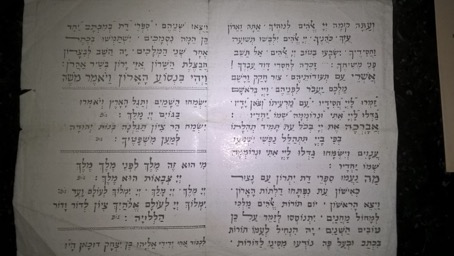
It is possible to listen to this passage in our section Our liturgy (see paragraph Shah'arit of Shabat by the H'azan Adolphe ZERBIB - Zal, at the exit of the Law).
On the Shabat H'atan, it is customary to release a second Sefer Torah and to read the passage "Avraham Zaken" alternating with the translation into Aramaic which appears in the Patah' Eliyahu. To listen to this passage, see the Shah'arit section of Shabat in Our liturgy section.
Rosh Hashana and Yom Kippur
This period of the beginning of the year is of great fervor, punctuated by a remarkable quality of the offices, which adds a supplement of soul to the prayer. It begins with the Sélih'ot (prayers of supplication) first in small committee, then with more and more faithful as Rosh Hashana approaches.
The last hours before Rosh Hashanah are an opportunity to gather the whole community and finish with a taste of the Shofar's ringtone and continue with a buffet embellished with the traditional Sfenj (oil fritters) that reward those who made the effort to get up early.
The celebration services continue to reach their culmination with Yom Kippur where officiating ministers dressed in white festive clothes conduct the service solemnly and under the religious guidance of the faithful gathered for the occasion.
First of all, the office of Kol Nidrei begins, all the Sifrei Torah from Holy Ark are going out, then our H'azanim and the Rabbi sing the song of "Kol Nidrei" (read 3 times).
At the Synagogue, the Shéma of Arvit/Maariv and Shah'arit services is sung by all the assembly and the officiating ministers together.
At Shah'arit, at the time of the exit of the Law, one recites the passage "Véata Kouma" before the Sefarim pass in the assembly.
The Seder Haavoda (during the Musaf service of Yom Kippur) is the highlight of the day and the faithful let themselves be carried by the voices of our H'azanims and the Rabbi. The use in our Synagogue is to add in the course of the day of Yom Kippur a few paragraphs from the small collection entitled "Mah'zor Katane" edited by the grandfather of our loyal and administrator Paul Attali, Rabbi Yossef Renassia (zal). Every year, we are pleased to see that many faithful have kept this book and continue to sing it with the officiating ministers.
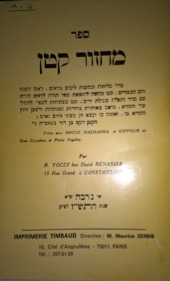
Shalosh Régalim (the 3 holidays: Sukkot, Pessah 'and Shavuot)
The custom is to add a Piyout before the Shah'arit half-Kaddich which precedes "Bareh'ou".
Pesach
In the Constantinois, this festival is associated with the Haguada of the Chief Rabbi of Constantine Sidi Fredj Halimi (zal). This Haguada is rich of a comment that stood out at the time because it wove a bridge between the story and the modern world to put it within reach of the assistant. This commentary is itself an enrichment of the Haguada of his own father Abraham Halimi said "Sidi Baha". This Haguada is entitled "Lo Amout Ki éh'ié", "I will not die, but I will live and I will recount the works of the Lord" (extracts from the Psalms of David 118 and 117). This is the profound meaning of this feast of transmission where the elders continue to be present through the transmission they have made and to perpetuate it. Everyone is supposed to relive the way of leaving Egypt as if he had witnessed it himself. To answer this obligation, it is undoubtedly the reason why a rich commentary was developed in order to enlighten the message of the narrative and that everyone can capture a part of intelligibility and to feel like himself being out of Egypt. Finally, the Haguada was also translated into the local language, Ladino, Yiddish and Constantine into Arabic Judeo, so that everyone is aware of the exit from Egypt.
Listen to the Haguada in Judeo-Arabic by Henri Levy in Our liturgy section.
Below the first page of Haguada of Chief Rabbi Sidi Fredj Halimi:
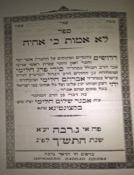
End of Sukkot and Pesach
The last days of Sukkot and Pesach, which conclude a period of family reunion, of intensity and fervor, the last verses of the Hallel are recited on the air of the farewell of the musicians, song of Malouf Constantinois which concluded a concert before the musicians retire. This song is interpreted with emotion by the Great Singer Raymond Leyris accompanied by his brother-in-law Sylvain Ghrenassia (once faithful of the Synagogue) violin Viola.
The translation of the piece at the origin of the air mixes shared feelings, both the joy of being found then the moment of separation and finally the joy that there will be to meet again ...
Our friend, the Chief Rabbi Honorary René Guedj who officiated in the Synagogues of Sarcelles and Val d'Oise (both located in France) gives us an extract in the beautiful CD on "The Psalms of Constantine" he recorded with André Taieb, Yohan Bismuth and Ylane Zerbib with the support of the Foundation of French Judaism. Below the cover of this CD:
Simh'at Torah
For Simh'at Torah, it is customary to install three armchairs symbolizing the 3 H'atanim, including the H'atan Bereshit and the H'atan Torah, next to the Holy Ark which contains the Sefarim. Some people sit down for a few moments in the morning service. On this occasion, the service is carried out by the young faithful of the synagogue and gives rise to reading on several Sefarim scattered in the synagogue so that absolutely all the faithful can go up to the Torah, then the young children take shelter collectively under the control of the Rabbi. Finally, the reading of Bereshit symbolizes the end of the holidays and the resumption of the sacred scroll at its beginning.
Between Pesach and Shavuot: the period of the Omer
During this period, we read the Pirké Avot (Maxims of the Fathers) during the Séouda Shlishit on Saturday afternoon. This gives rise to the translation of each paragraph so that everyone can understand the text and learn from it.
Shavuot
The 10 commandments "Matan Torah": it is the association of ideas that comes immediately to mind when we talk about the beautiful festival of Shavuot, first with the reading of the chapter of the Torah related to it, read with Taham Elyon (High) then because at the Synagogue has retained the use of reading Rabbi Saâdia Gaone's homiletic dissertation on the Decalogue. This dissertation and its translation into Arabic Judeo had a considerable impact in Algeria, so important was the desire of the faithful to assimilate the divine commandments. A first edition of this text was translated by Rabbi Isaac MORALI (Zal, in 1913, while he was Honorary Director of the Talmud Torah of Algiers) and, from the 1935 edition, this text was completed with a preface Commendation of Rabbi EISENBETH (Zal, Chief Rabbi of Algeria). This text is a commentary of a page or two of each of the 10 commandments. After the reading of the Torah, 5 Commandments are sung, in Arab Judeo, the first day and 5 commandments follow the second day. In Constantine, each of the 11 oratories and synagogues of the city had its 10 readers and the faithful flocked there to listen to their.
Listen to the 7th commandment sung by the minister officiating Yossef Levy of Constantine, accompanied by Raymond Leyris and Sylvain Ghrenassia, cf. page Our liturgy.
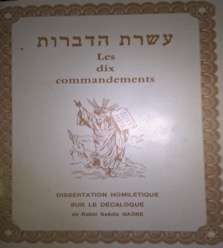
The three terrible weeks (Ben Hamétzarim)
During these three weeks, it is customary to read the Haftara in a particular, slow, sad expression as a reminder of the destruction of the Temple of Solomon.
We invite you to listen to one of these haftarot (the haftara H'azon) read by Rabbi Abner Nacache father of one of our faithful and Rabbi of the Great Synagogue of the Midrash in Constantine.
The Milot
For Brit Mila, it is customary for our Synagogue to add two songs that are contained in the little collection of Daniel Renassia: El Yakchiv Lekhol Takhanounai, Eine devar hasdi.
Listen to these passages song by our h'azan Adolphe Zerbib (zal) on our page Our liturgy.
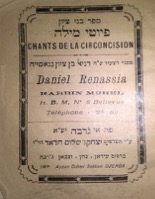
The Tehillim: The Book of Psalms of David
This book which is part of the Hagiographers (Kétouvim) is read on occasion in all circumstances, happy or sad. To remind the memory of their dear departed, the faithful are used to celebrate an office in their memory. On this occasion Psalms are read and when the families have remained attached, the reading is done according to the Constantine rite which requires a precise knowledge of the text, the sound and the cantillation which subtly alternates the modes of oriental music Malouf and arouses the emotion of the present assistance.
For a reading of the Tehillim in the purest Constantinian tradition:
Listen to Jeannot ATHLAN (zal) who was a faithful of our Synaogue for many years and known and recognized for his perfect mastery of this text. His voice also served as a link to the actor Jean Benguigui in the film of "Grand Pardon" with french actor Roger Hanin.
To listen to the psalms, go to the page Our liturgy.


